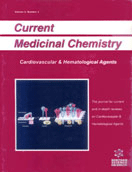Abstract
Platelets play a pivotal role in the pathogenesis of atherothrombosis, believed to be integrally involved in both the development and progression of atherosclerotic heart disease, as well as in its acute thrombotic complications. Antiplatelet therapy constitutes the cornerstone in the management of patients with acute coronary syndromes and generally high-risk patients with atherothrombosis. Until recently, long-term antiplatelet therapy for the treatment and prevention of the complications of atherothrombotic disease was traditionally limited to aspirin. The availability of the thienopyridines, in particular clopidogrel, represents an important addition to the physicians armamentarium. Clopidogrel is currently one of the most widely prescribed drugs for the treatment of symptomatic coronary artery disease. Aspirin and clopidogrel interfere with platelet activation in complementary, but separate pathways. Aspirin irreversibly inhibits cyclooxygenase, thus preventing the production of thromboxane A2, which is a prothrombotic and vasoconstrictive substance. Clopidogrel, a newer thienopyridine which has largely supplanted ticlopidine due to a more favorable safety profile, irreversibly prevents platelet activation by blocking one of the three known adenosine 5-diphosphate (ADP) receptors (the P2Y12 receptor) on the platelet surface, thus interfering with platelet activation, degranulation and aggregation. Both these antiplatelet agents have a potent protective effect against adverse vascular events, but the combination of these two agents has an even stronger antiplatelet effect translating into superior antithrombotic protection in coronary, cerebral or peripheral arterial disease, without an inordinate increase in bleeding complications. A number of seminal clinical trials have demonstrated and confirmed the incremental benefit and efficacy of the combination of clopidogrel and aspirin therapy above and beyond that of aspirin alone, with multiple other important large-scale clinical trials currently ongoing. Newer data are being accumulated from studies where indications for the use of clopidogrel and aspirin continue to expand into other patient groups, rendering this dual antiplatelet drug therapy a sweeping combination in Cardiology. However, important issues remain to be further and more thoroughly explored about the benefit of this antiplatelet drug combination in these other patient groups, such as in patients with heart failure, where preliminary data indicate a favorable effect on thrombotic vascular events, in patients with atrial fibrillation, where there is hope that this combination may replace or be an alternative treatment modality to coumadin in certain subpopulations, in patients undergoing demanding catheter ablation procedures, where data point to a protective effect from thromboembolic events. Another pertaining issue to be further investigated is the occurrence of drug-resistance observed in some patients for both these antithrombotic agents. This article is a comprehensive review of all these data and the landmark trials on the two antiplatelet agents, the issues involved and the current recommendations for their use in patients with atherosclerotic heart disease and other cardiovascular disorders and procedures.
Keywords: aspirin, clopidogrel, antithrombotic drugs, ischemia, coronary artery disease, coronary angioplasty, coronary stenting, coronary thrombosis
 2
2













